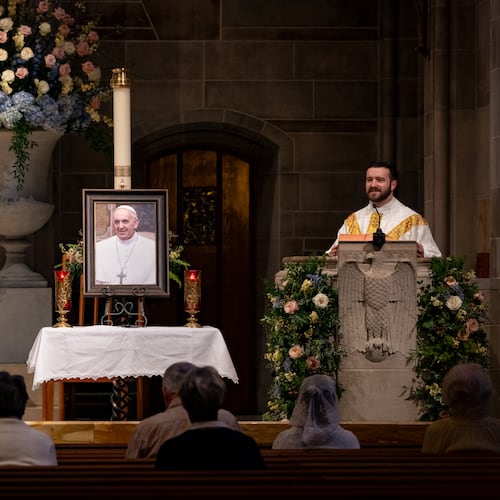Atlanta Mayor Andre Dickens said Thursday the city hopes to extend the life of the Beltline Tax Allocation District to pay for transit and affordable housing beyond 2030, when the original redevelopment tax sunsets.
Dickens’ comments, made during an interview at the Atlanta Press Club, were brief but mark the first time the mayor has talked publicly about how to pay for the transit vision he unveiled earlier this month, the cost of which is likely to run into the billions.
A key part of his plan involves light-rail on the Beltline. After pulling his support for bringing light-rail to the Eastside Trail first, Dickens now wants to start service on the Southside Trail, which he said would better align with areas where more riders are transit-dependent while also minimizing disruptions to businesses.
Continued revenue from the tax district, commonly referred to as a TAD, is one part of the funding strategy Dickens laid out. A TAD is a designated area in which property tax revenue growth is allocated to pay for infrastructure within the district.
Dickens said money from More MARTA, the halfpenny transit sales tax approved in 2016, would also be tapped for the Southside portion, which the city wants to do without federal money.
“The money is there,” he said. “This is something we have the funding for.”
Dickens spoke broadly and said he intends to share more this summer when the city and Atlanta Beltline will engage in “a robust community process.”
Michael Smith, the mayor’s press secretary, provided a statement but did not respond to questions seeking more specifics.
“This administration will continue to explore all potential avenues to support the mayor’s vision of Atlanta being the best place to raise a child, and that includes a comprehensive review of funding options to support equitable transit solutions to create healthy, thriving communities in every corner of our city,” Smith said.
Credit: Miguel Martinez-Jimenez
Credit: Miguel Martinez-Jimenez
In a statement, Atlanta Beltline officials said the organization supports the mayor’s proposal.
“The extension of the Beltline TAD will allow us to continue to make a positive impact on the city by creating car-free options for moving around Atlanta, long-term affordable housing and economic development,” the statement says. “We look forward to working with the Mayor’s team, our other TAD Partners, and the community to make this vision a reality.”
Extending the TAD would require support from the Atlanta City Council, Atlanta Board of Education and the Fulton County Board of Commissioners. It’s unclear where those groups stand on the issue.
City Council President Doug Shipman and Fulton County Commission Chairman Robb Pitts declined to comment. Erika Mitchell, who chairs the Atlanta Public Schools Board, did not immediately respond to a request for comment.
Dickens has been vocal in the past year about his frustrations with MARTA, and he’s made big pronouncements about the transit projects he wants to prioritize, like Southside light-rail and four new infill rail stations, including one at Murphy Crossing that would connect with the Southside light-rail. Often those announcements have caught elected officials and the public by surprise.
Both of the local funding options Dickens floated this week as solutions are politically fraught and would require buy-in from the public and those other groups.
When it comes to More MARTA money, the city and the transit agency have yet to agree on an up-to-date project list. The Southside light-rail project was one of 17 possibilities on initial lists but doesn’t appear on a more recent list of the top 10 priority projects.
Discussions about the priority projects are part of an ongoing dispute over how More MARTA money has been spent so far. The city contends MARTA owes the capital project fund close to $70 million, while the transit agency contends it owes less than $1 million. Whatever amount the two sides agree on would ultimately become available for projects like Southside light-rail.
Additional More MARTA money could also be freed potentially if Dickens’ proposal to abandon the Eastside light-rail plans proceed. He’s suggested modifying the plans to extend the Atlanta Streetcar to the Beltline, but not on it, which would lower the cost of the projected $230 million project.
Credit: Ben hendren
Credit: Ben hendren
Extending the TAD could be even more complicated than the More MARTA funding logistics, if the difficulty creating it is any indicator.
Creating the TAD required convincing the Atlanta City Council, the Atlanta Board of Education and the Fulton County Board of Commissioners to forgo taxes from any increases in property value for 25 years. It ultimately led to a lawsuit challenging the school district’s participation.
The pitch originally was that by 2030, TAD revenue would cover the costs of building the trail and light-rail around the 22-mile loop.
Two decades in, there’s no transit and the TAD won’t end up covering the costs of the trail itself. A special service district imposing an additional tax on commercial properties and multifamily units was created in 2021 to help bridge the gap.
It’s unclear what terms Dickens would seek for a new TAD and how long he would need to extend it. But the council, county and schools would need to agree again to forgo tax revenue they would otherwise receive.
Peter Bluestone, a public finance researcher at Georgia State University’s Andrew Young School of Policy Studies, said he would anticipate “lively” debate similar to what arose when the TAD was first passed.
There are opportunity costs involved by forgoing property tax revenue, and each entity will have to decide if the benefits outweigh the costs, he said.
“I would imagine everyone is looking down at their budget,” Bluestone said. “They may be reticent to sign off on something like that again for an extended period.”
Dickens did not say, and his office would not answer, whether he is considering other types of taxing districts to fund Beltline transit in addition to extending the TAD.
Beltline Rail Now, which has advocated for the city to stick with plans to start on the Eastside Trail, has in the past proposed the creation of a special assessment district where proceeds would be dedicated to transit.
They recommended establishing a transportation improvement district and using that revenue in conjunction with the TAD and federal funding. Matthew Rao, the group’s president, said he wants to see the city show how the math could work if the only revenue sources are the TAD and More MARTA.
“Extending the TAD will help with that, but it won’t be a piggy bank that doesn’t require other sources of funding,” Rao said.
It’s unclear whether there’s money from the existing TAD to put toward any of the transit projects.
Ken Edelstein, a spokesperson for the group Better Atlanta Transit, which has opposed the Eastside light-rail plans, also said he is unsure whether extending the TAD could cover the costs of Dickens’ plans.
“I’m skeptical that it could fund a lot,” he said.
Credit: Atlanta Beltline Inc.
Credit: Atlanta Beltline Inc.
The costs of light-rail are one reason his group has pushed for the consideration of other options, which they dub a “wheels and heels” approach. Edelstein said light-rail on the Southside Trail makes more sense than on the Eastside, however.
He commended Dickens for pressing pause on the Eastside portion but said it’s too soon to tell whether the mayor’s overall transit vision is realistic.
Historically, “these grand plans and sweeping statements often are nice, but they’re not how things generally turn out,” Edelstein said, adding that his group advocates for taking it project by project.
Efforts to extend other TADs, like one funding Westside projects, have been controversial. It’s unclear what support there would be to extend the Beltline TAD.
Typically, TADs are used to incentivize development in economically depressed areas. That’s not the case for sections of the Beltline anymore. In fact, part of Dickens’ rationale for abandoning the Eastside plans is because of how developed that trail segment has become.
“Part of the challenge is the business interruptions,” Dickens said Thursday. “The front door to their business would be either too loud for them to operate or too dusty for them to operate — too much of a nuisance.”
Extending the TAD could also be complicated by state law that says only 10% of a city’s tax digest can be within one. Atlanta likely exceeds that cap already, in part because of the size of the Beltline TAD, which comprises 6,500 acres. Officials at Invest Atlanta, which oversees the city’s 10 TADs, did not immediately respond to a request for comment, but city officials have said previously that Atlanta was over the cap.
The mayor’s office did not respond to a question about the potential impact of the cap on Dickens’ plans or say whether his office has had conversations about extending the TAD with any officials from Atlanta Public Schools, Fulton County or the City Council.
Responding to a question about the Southside light-rail proposal, Dickens said he sees construction beginning by the end of 2029, when his second term would wrap up if his reelection bid is successful.
About the Author
Keep Reading
The Latest
Featured






